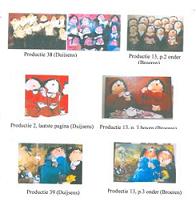 “The law does not allow for additional protection of the maker of a work against so-called slavish imitation of a style or of elements of style.”
“The law does not allow for additional protection of the maker of a work against so-called slavish imitation of a style or of elements of style.”
Supreme Court of the Netherlands, 29 March 2013 (Duijsens/Broeren).
Although the legal concept of coat-tail riding is usually associated with trademark law, it is certainly not unfamiliar to copyright law. But whereas in trademark law the mere association with a popular brand is used to sell the non-identical brand of the coat-tail rider, in copyright law it is often the style of an artist or a work , that is used as a means to stay as close to these work(s) without literally imitating them.
Unfortunately for those whose coat-tails are ridden, style can’t be copyrighted, at least not in the Netherlands. Neither style in the broader sense of the concept, not associated with a single person, nor in the narrow sense, that sees to the personal style of an individual artist. As one can imagine, it can be quite annoying to see your own personal style imitated and exploited commercially. In this case, the Dutch paintress Gerdine Duijsens, noticed that the defendant, a ‘painter of merry scenes’ not only made identical copies of five of her paintings, but also painted other works, in fact all his works, in a style that closely resembled her specific style of painting.
In November 2011 the Court of Appeal concluded that the defendant did infringe Duijsens’ copyright with regard to the five copied paintings (pictures in the judgement), but that her style was not copyright-protected, because style is not a concrete design that qualifies for copyright protection.
But, and that is the interesting aspect of this case, the Court of Appeal did not leave it at that and ruled that the ‘other’, stylishly similar works of the defendant were to be considered illegitimate, because they unnecessarily, slavishly imitated the paintings and / or the style of paintress Duijsens. That the defendant signed the paintings with his own name couldn’t alter this decision. “The court considers this imitation of style not only as striking, but also as unnecessary. He has failed to do everything that is reasonably possible and necessary to prevent a risk of confusion that originates from the similarity of the paintings.” The defendant brought the case before the Supreme Court.
The Supreme Court reversed the judgement of the Court of Appeal, concluding that the Court erred in applying the doctrine of slavish imitation of (physical) products to (elements of) style:
“3.5 The complaint is upheld. According to settled case-law of the Supreme Court, is does not necessarily follow from the use of the same material, the processing of this material following the same method that renders a specific artistic effect, or following the same style, that a work is imitated in the sense of article 13 Dutch Copyright Act. The Copyright Act does not give an exclusive right to a person that is working within a style (that is characteristic for that person). The idea behind this case-law is that copyright protection of abstractions such as stylistic elements would entail an unacceptable restriction on the freedom of creation of the maker, and thus constitutes a hindrance for cultural developments.
3.6 Against this background, it must be held that the law does not allow for additional protection of the maker of a work on the basis of Art. 6:162 Civil Code [tort, unlawful acts –blogger] against so-called slavish imitation of a style or of elements of style. Any other interpretation would lead to a result that the above mentioned case-law seeks to prevent. The foregoing does not preclude that slavish imitation of a style or elements of style can be unlawful in other circumstances, but it is not sufficient that such imitation is unnecessary and that it creates confusion among the public
The case-law to which the Supreme Court refers in 3.5., can be shortly summarized as that the mere development or initiation of a new fashion or style cannot lead to copyright or design protection. It must be examined, considering the relevant fashion, trend or style in a specific field, whether an alleged infringer has kept, with his design, a sufficient distance from the specific original work and whether he has, again with his design, expressed the relevant fashion, trend or style of design in a sufficiently personal way.
In the Netherlands, ‘slavish imitation’ is often used as a safety net when copyright or other IP-rights can’t protect a work or a design (most cases regard industrial designs). In many cases it can be read between the lines that it would be unfair and contrary to the sense of justice of the judge or the public, if an evident copy was to be allowed, even if the ‘original’ work couldn’t classify for IP- protection. It goes without saying that the mere existence of such a safety net is a subject for discussion. This judgement of the Supreme Court will not end that debate, but will certainly give some clear markers with regard to the topic of style.
A full Summary of this case will be added to the Kluwer IP Cases Database.
_____________________________
To make sure you do not miss out on regular updates from the Kluwer Copyright Blog, please subscribe here.
Kluwer IP Law
The 2022 Future Ready Lawyer survey showed that 79% of lawyers think that the importance of legal technology will increase for next year. With Kluwer IP Law you can navigate the increasingly global practice of IP law with specialized, local and cross-border information and tools from every preferred location. Are you, as an IP professional, ready for the future?
Learn how Kluwer IP Law can support you.


